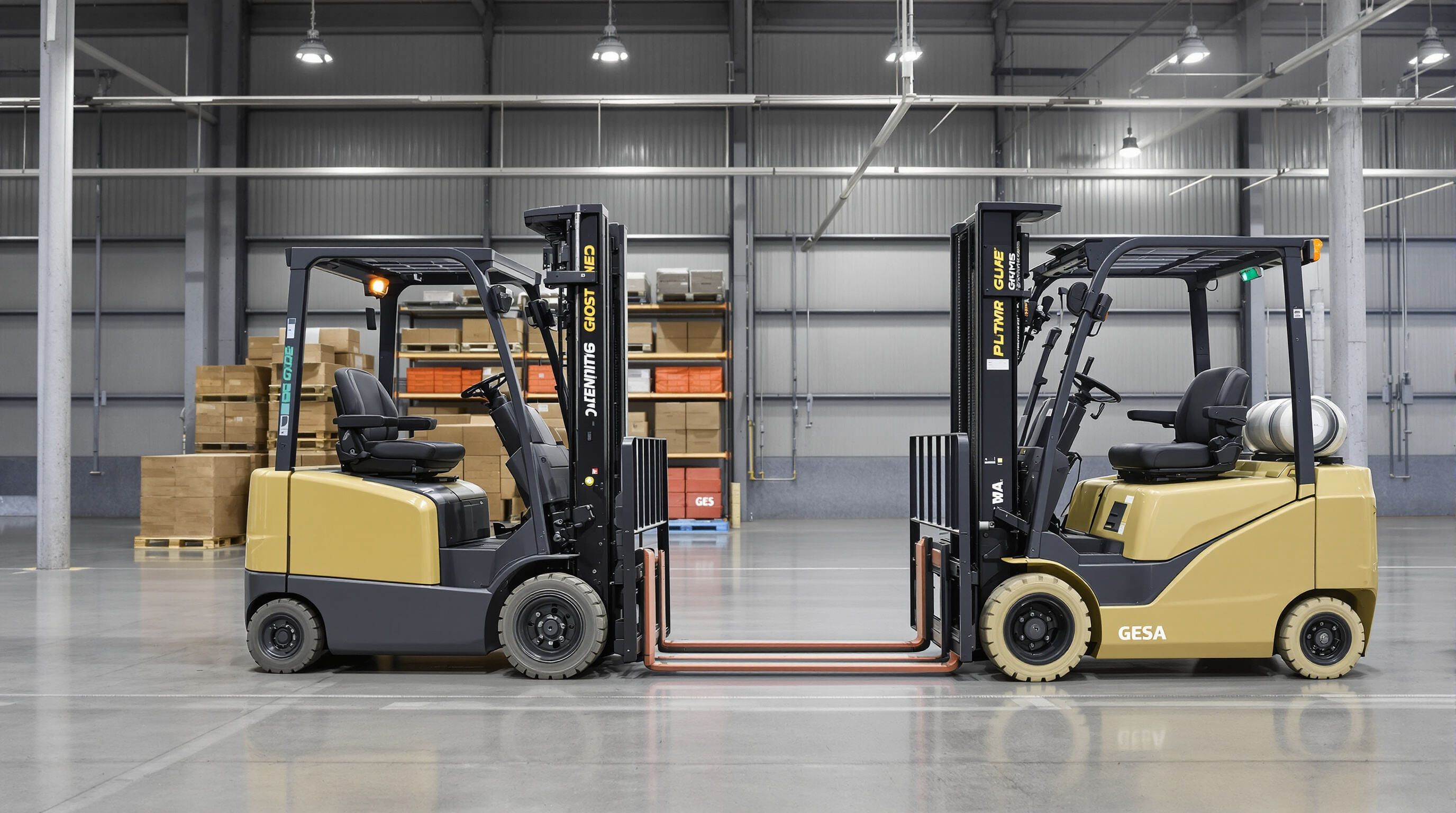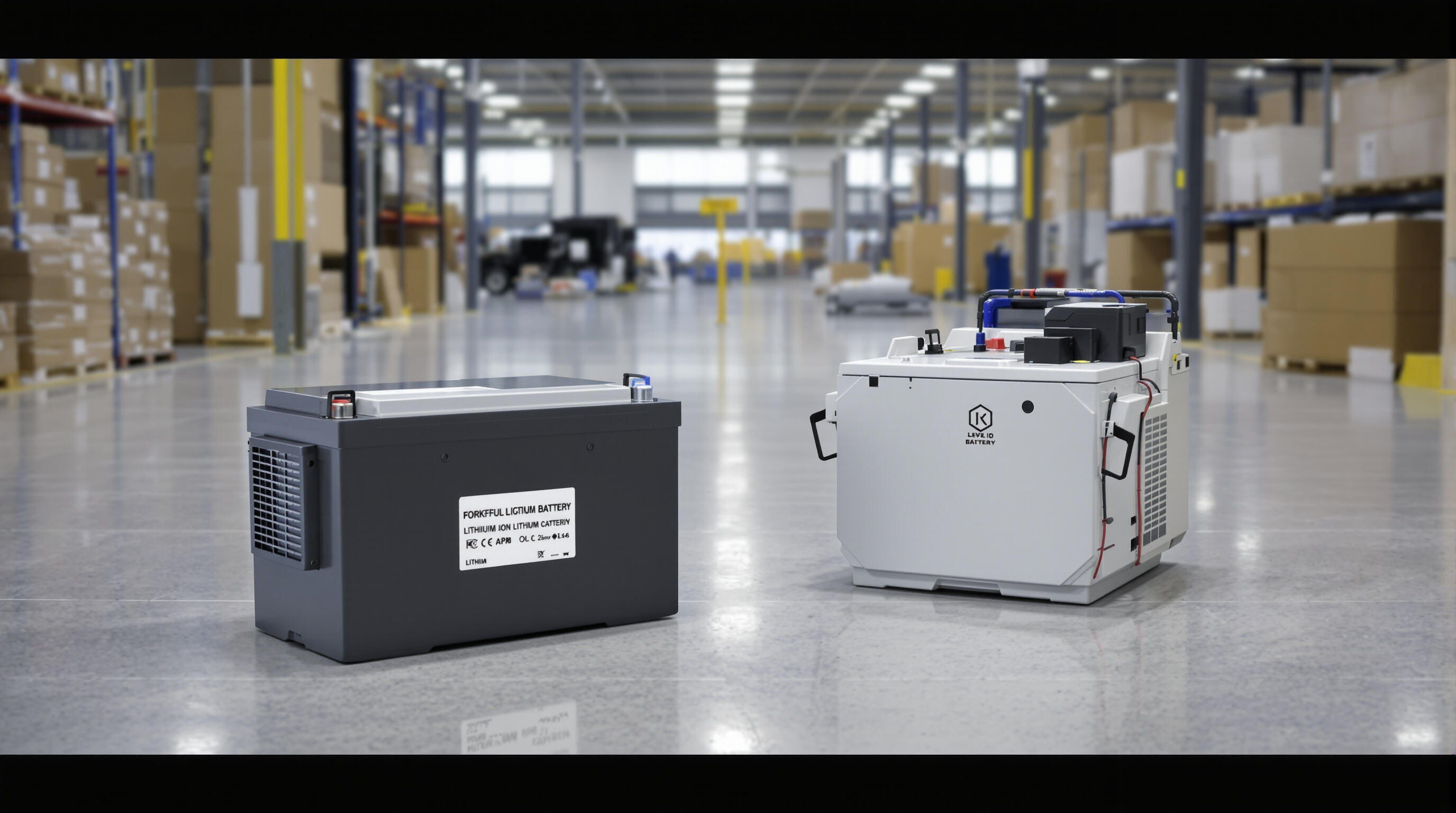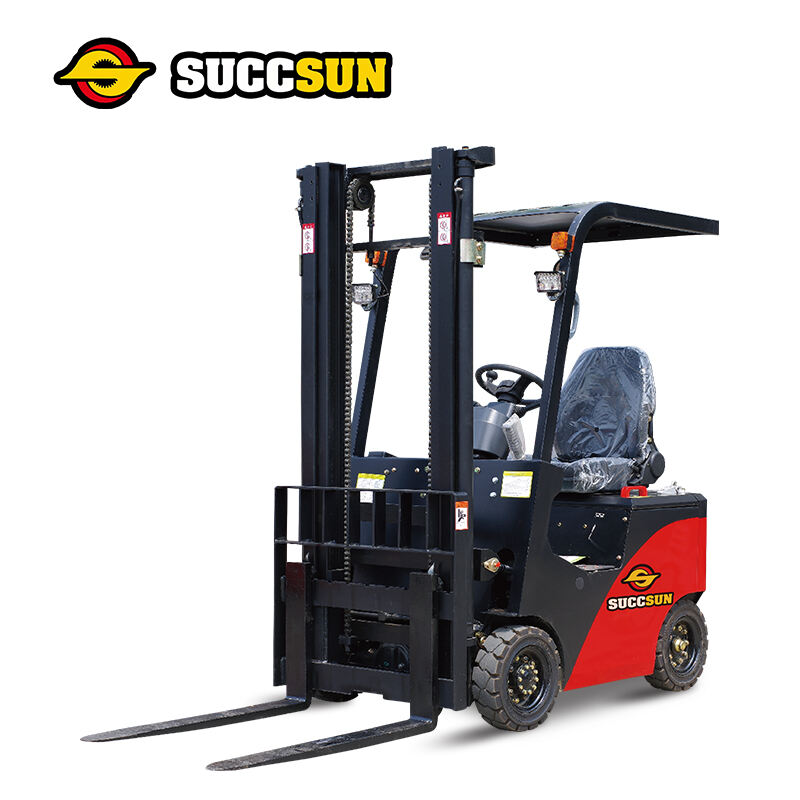Understanding Electric Forklifts: Types, Features, and Ideal Applications
What Defines an Electric Forklift and How It Differs from Gas Models
Electric forklifts run on batteries rather than traditional combustion engines, so there are no harmful exhaust fumes coming out the back end. Plus, they're much quieter too around 75 decibels or so, making them great for working inside buildings without driving everyone crazy from all that engine noise. Compared to their gas powered cousins, these electric versions don't need any special fuel tanks stored somewhere, won't pollute the immediate area while running, and actually have about 30 percent less components moving around inside. That means less stuff breaking down over time, saving money on repairs down the road. Because of all this, many companies find them especially useful in places like cold storage warehouses or labs where keeping the air clean matters a lot, such as meatpacking plants or medicine manufacturing sites where even tiny amounts of contamination could cause big problems.
Types of Electric Forklifts (Class 1, 2, 3) and Their Core Applications
OSHA categorizes electric forklifts into three classes based on design and use:
- Class 1 (Electric Motor Rider Trucks): Counterbalance forklifts with cushion or pneumatic tires, commonly used in loading docks and wide-aisle warehouses.
- Class 2 (Narrow Aisle Forklifts): Includes reach trucks and order pickers designed for high-density storage, featuring turning radii under 6 feet.
- Class 3 (Electric Hand-Rider Trucks): Walk-behind pallet jacks and stackers ideal for retail backrooms or small-scale logistics operations.
Class 2 models account for 42% of narrow-aisle warehouse deployments due to their space efficiency (Warehouse Efficiency Report, 2023).
Common Use Cases in Warehouses and Logistics Centers
Electric forklifts are optimal for multi-shift operations requiring consistent uptime and low emissions, including:
- E-commerce fulfillment centers with 24/7 order processing.
- Cold storage facilities where diesel exhaust could compromise product integrity.
- Automotive parts distribution hubs that prioritize fast charging over refueling delays.
Their ability to operate in aisles as narrow as 8 feet makes them essential in modern automated storage and retrieval systems.
Electric vs. Gas Forklifts: Performance, Emissions, and Operational Trade-offs

Pros of an Electric Forklift: Zero Emissions and Indoor Air Quality Benefits
Unlike traditional gas powered models, electric forklifts don't emit any exhaust fumes at all, which makes them perfect for working inside places such as storage facilities or meatpacking plants where fresh air matters. Without those loud internal combustion engines running around, there's better breathing room for everyone plus significantly lower noise levels throughout the day. Plus, these machines run on efficient motors that create much less heat compared to their counterparts. That means less stress on heating and cooling systems when operating in temperature sensitive areas like pharmaceutical warehouses or cold storage units.
Cons of an Electric Forklift: Limited Runtime and Charging Dependencies
Battery-powered units typically run for 6–8 hours per charge, necessitating planned downtime for recharging. While lithium-ion batteries can recharge in 1–2 hours, high-demand operations may still require backup units during peak shifts. In cold storage environments, extreme temperatures can reduce battery efficiency by up to 30%, affecting performance.
When Gas Forklifts Are Still the Better Choice
Propane or diesel forklifts remain preferable for outdoor applications such as lumber yards or construction sites, where rugged terrain and heavy loads (over 8,000 lbs) demand higher torque. Gas-powered models also perform better in cold climates, as engine heat prevents hydraulic fluid from thickening.
Resolving the Uptime Challenge: High Demand vs. Charging Downtime
Operations using electric forklifts manage downtime through opportunity charging—15-minute top-ups during breaks—and swappable battery systems. Lithium-ion technology supports partial charging without memory degradation, while advanced telematics monitor State of Charge (SoC) to optimize fleet rotation and minimize idle time.
Total Cost of Ownership: Upfront Price, Operating Savings, and Long-Term Value
Upfront Investment: Electric Forklift Price Range and Brand Variability
Electric forklifts typically range from $25,000 to $60,000 depending on lift capacity (3,000–10,000 lbs), mast height, and battery type. Leading manufacturers vary in pricing based on motor efficiency, warranty coverage, and integrated telematics. Although gas models start around $18,000, the higher initial cost of electric units is often offset by long-term operational savings.
Operating Cost Savings Over 5–10 Years
Switching to electric forklifts means no more spending money on fuel, plus maintenance costs drop around 40% because there just aren't as many parts wearing out over time. Looking at the big picture, businesses typically end up saving somewhere around $22k on each machine they own over ten years when factoring in all those oil changes, filters needing replacement, and fixing engines that break down. When it comes to running costs, charging up a lithium ion battery only sets back about $1.50 for each full charge cycle. That's way cheaper than what companies used to pay filling up tanks with gas which could easily run between $10 to $15 every time.
Data Point: Electric Models Save Up to 30% Annually in Operating Costs
A 2023 Logistics Tech Review found that warehouses using electric forklifts reduced annual operating expenses by 28–32% through lower energy consumption and reduced labor hours for maintenance. This trend supports the broader industry shift toward electrification in material handling.
Lifespan Comparison: Electric vs. Internal Combustion Forklifts
With proper care, high-quality electric forklifts last 12–15 years, outlasting gas models (8–12 years) that suffer from engine wear. Lithium-ion batteries enhance longevity, delivering 1,500+ full charge cycles before reaching 80% capacity—twice the lifespan of lead-acid alternatives.
Battery Technology and Charging Infrastructure: Lead-Acid vs. Lithium-Ion

Electric forklift performance hinges on battery selection, with lead-acid and lithium-ion (LiFePO4) dominating industrial applications. Understanding their trade-offs ensures optimal ROI and workflow efficiency.
Lead-Acid vs. Lithium-Ion (LiFePO4): Performance and Cost Differences
Lead-acid batteries are more affordable upfront ($4,000–$6,000) but need replacement every 3–5 years. Lithium-ion systems carry higher initial costs ($10,000–$15,000) but offer 2–3 times the lifespan. Modern lithium batteries achieve 95% energy efficiency, compared to 70–80% for lead-acid, reducing warehouse energy costs by 18–22% annually (Industrial Energy Report 2024).
Battery Lifespan and Charging Cycles: 1,500+ Cycles with Lithium
Lithium-ion batteries endure 1,500–3,000 full charge cycles with minimal capacity loss, far exceeding lead-acid’s 500–1,200 cycle range. Integrated battery management systems (BMS) prevent overcharging and extend operational life to 8–10 years—double that of typical lead-acid batteries.
Charging Infrastructure Needs for Single Units and Fleets
| Requirement | Lead-Acid | Lithium-Ion |
|---|---|---|
| Charging Space | Dedicated ventilated rooms | Any dry location |
| Charger Cost | $2,000–$4,000 per unit | $1,500–$3,000 per unit |
| Fleet Scalability | Complex battery swapping | Opportunity charging |
Lithium systems reduce infrastructure costs by 30–40% by eliminating the need for acid containment and ventilation.
Opportunity Charging and Workflow Efficiency
Lithium-ion batteries support partial charging without degradation, enabling 15–30 minute opportunity charges during breaks. This sustains continuous 24/7 operations and avoids the 8-hour charging delays associated with lead-acid systems, boosting productivity by 18% in multi-shift warehouses.
Swappable vs. Fixed Battery Systems: Pros and Cons
Swappable lead-acid systems suit multi-shift operations but require significant labor—over $20,000 annually—for battery changes. Fixed lithium batteries eliminate manual swaps and reduce labor costs by 75% through onboard charging, though they require strategic planning during fleet electrification.
Maintenance, Safety, and Compliance: Reducing Downtime and Risk
Lower Maintenance Needs Due to Fewer Moving Parts
Electric forklifts need around 30 to maybe even 40 percent less maintenance compared to their gas counterparts because they have simpler mechanical setups. Think brushless motors instead of complicated combustion engines, plus way fewer fluids running through them. These electric models don't deal with spark plugs, oil changes, or those pesky exhaust parts that always seem to cause trouble somewhere down the line. Warehouse managers who run multiple shifts report something pretty impressive too. The numbers from actual operations suggest these electric designs cut down on unexpected breakdowns by roughly 1500 hours each year across entire fleets. That kind of reliability makes all the difference when trying to keep operations running smoothly without constant interruptions for repairs.
Key Operational and Service Costs Over Time
Electric forklifts might cost more upfront, but they save money over time because they need fewer parts replaced. Companies can expect to save around $2,800 each year just on filters and fluids alone. Plus, electricity costs are way cheaper at about 15 cents per kilowatt hour compared to propane which runs about $3.50 per gallon. Many warehouses are now using predictive maintenance systems with vibration sensors that help cut down on unexpected breakdowns by roughly 18 percent according to what we've seen across various logistics operations. When looking at the big picture, most businesses find that after 5 to 7 years, running electric models ends up costing anywhere from 25 to 35 percent less than sticking with traditional gas powered forklifts throughout their entire lifespan.
Safety Protocols for Battery Handling and Charging Stations
Safety is really important when dealing with lithium-ion systems. According to OSHA guidelines, facilities should have fire rated areas for charging, workers need appropriate protective gear if there's any risk of acid exposure (though this mainly applies to lead-acid batteries), and regular temperature checks are a must. Good practice means keeping charging stations separated by about four feet from each other, which helps prevent accidental contact. Also worth noting is the use of automatic shut down features when units start getting too hot. Companies that invest in thorough employee training see around half fewer accidents on site. Weekly safety audits help maintain compliance with those ANSI B56.1 standards most workplaces follow. The numbers back it up but what matters most is creating a culture where everyone takes safety seriously day after day.
FAQs
What are the main differences between electric and gas forklifts?
Electric forklifts run on batteries, producing no exhaust fumes and less noise compared to gas models. They have fewer moving parts, leading to reduced maintenance costs and are ideal for indoor use.
How long can an electric forklift operate on a single charge?
Electric forklifts generally operate for 6-8 hours per charge. Lithium-ion batteries can recharge in 1-2 hours, although backup units may be needed during high-demand periods.
What are the cost benefits of switching to electric forklifts?
Switching to electric forklifts can reduce fuel costs since they run on electricity, which is cheaper than gas. Over time, maintenance costs decrease around 40%, leading to significant cost savings over 5-10 years.
What types of batteries are used in electric forklifts?
Electric forklifts primarily use lead-acid and lithium-ion batteries. While lead-acid batteries are less expensive initially, lithium-ion batteries offer a longer lifespan and increased efficiency.
How does charging infrastructure affect operational efficiency?
The type of charging infrastructure can significantly impact efficiency. Lithium-ion batteries support opportunity charging, allowing for quick top-ups and reducing downtime, whereas lead-acid batteries require longer charging cycles.
Table of Contents
- Understanding Electric Forklifts: Types, Features, and Ideal Applications
- Electric vs. Gas Forklifts: Performance, Emissions, and Operational Trade-offs
- Total Cost of Ownership: Upfront Price, Operating Savings, and Long-Term Value
- Battery Technology and Charging Infrastructure: Lead-Acid vs. Lithium-Ion
- Maintenance, Safety, and Compliance: Reducing Downtime and Risk
-
FAQs
- What are the main differences between electric and gas forklifts?
- How long can an electric forklift operate on a single charge?
- What are the cost benefits of switching to electric forklifts?
- What types of batteries are used in electric forklifts?
- How does charging infrastructure affect operational efficiency?


